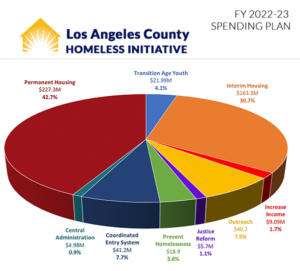 As Los Angeles County prepares to intensify and refocus its efforts to fight homelessness, the Board of Supervisors approved a $532.6-million spending plan that significantly expands permanent and interim housing solutions and increases funding for local cities in the coming fiscal year, which begins July 1.
As Los Angeles County prepares to intensify and refocus its efforts to fight homelessness, the Board of Supervisors approved a $532.6-million spending plan that significantly expands permanent and interim housing solutions and increases funding for local cities in the coming fiscal year, which begins July 1.
About 87% of the spending plan, $466.75 million, will come from Measure H, a ¼-cent sales tax approved by County voters in 2017 specifically to address and prevent homelessness. The remaining $65.86 million represents state funding.
The spending plan is a significant portion of the County’s overall spending to address homelessness, which exceeded $1 billion in the current 2021-22 fiscal year. The spending plan approved for FY 22-23 includes:
- $227.3 million for permanent housing, which accounts for 42.7% of the total budget. This includes a significant increase in permanent supportive housing services to continue serving about 13,300 individuals and families and begin serving an additional 7,700 individuals and families. Permanent supportive housing provides long-term rental subsidies and intensive case management services to people who have experienced chronic homelessness and have disabilities, chronic medical conditions, and/or behavioral health conditions.
- $163.3 million for interim housing, which accounts for 30.7% of the total budget, to help sustain about 5,000 of the County’s total portfolio of interim housing beds, including 400 new beds for people needing high acuity care, some of which will be on the County’s first site with 24/7 admissions. According to the Los Angeles Homeless Services Authority’s 2021 Housing Inventory Count, the region’s shelter capacity on any given night is about 25,000 beds.
- $20M to go directly to local jurisdictions to be used for their unique local needs, more than doubling last year’s amount, even as the County explores additional co-investment opportunities with cities going forward.
The Homeless Initiative, a part of the County’s Chief Executive Office, serves as the central coordinating body for the County’s massive effort to prevent and address homelessness. It directs strategies and funding for street-based outreach, interim housing, permanent housing, and supportive services for people experiencing homelessness, as well as to prevent people from becoming homeless in the first place, including by facilitating affordable housing development.
As it kicks off the second half of Measure H’s 10-year term, the Homeless Initiative is beginning to implement a new framework for tackling the crisis, as reflected in this spending plan. That new framework calls for:
- Maximizing the capacity of mainstream government systems, such as the health care and social services systems, to serve as the first and largest safety net for people who are vulnerable, especially those with housing insecurity.
- Ensuring that the County’s rehousing system remains a system of last resort, focused primarily, but not exclusively, on helping people who have been persistently underserved, those with the most complex challenges who require ongoing, focused and resource-heavy intervention to help them get off the streets and into housing.
- Forging stronger partnerships with cities, including by pooling resources to develop more permanent housing, and by coordinating with them when encampments are being decommissioned to provide pathways to housing and services.
Supervisors and County Leaders Comment on Spending Plan
“I enthusiastically support the LA County Homeless Initiative’s FY 22-23 budget which invests $466.75 million of Measure H and $65.86 million of state funds for services to residents throughout our 88 cities and unincorporated areas,” said Board of Supervisors Chair Holly J. Mitchell. “We are at the halfway mark for Measure H spending and doubling down on investing in our Housing First approach. 73.4% of the budget is allocated for sustaining and increasing permanent and interim housing. Housing is the one strategy that will stop the tidal wave of people living on our streets. The Homeless Initiative’s budget demonstrates the commitment to creating housing and providing much needed services for our unhoused Angelenos.”
“This budget reflects the County’s commitment to expanding local solutions funding for the 88 cities in the County,” said Supervisor Hilda L. Solis. “As we continue to reform our homeless services system, I am glad that the County is providing additional opportunities for cities to serve their homeless residents. I look forward to working with the Homeless Initiative on implementing more creative partnerships with our cities to establish a regional approach to tackling homelessness, particularly in the San Gabriel Valley.”
“Right now, it is of paramount importance that we cement our successes and double down on investments in homelessness prevention and rehousing,” Supervisor Sheila Kuehl said. “Over the last five years, we have dramatically scaled up the housing and services. We’ve sheltered more than 100,000 people, many of whom later became among the 80,000 people permanently housed by the County. We’ve also prevented 20,000 households from becoming homeless. That’s massive. We’ve learned a lot and are now refining our strategies to ensure the County is addressing both the homeless and the housing crises as effectively as possible. This budget significantly increases funding to cities and takes the first step toward adopting the new Homeless Initiative Framework, a practical and specific plan to accelerate our ability to prevent people from falling into homelessness and to rehouse more people more quickly.”
In addition to approving the budget for FY 2023-24, the Board also approved a motion by Supervisor Janice Hahn to immediately implement the Homeless Initiative budget process for FY 2023-24.
“It’s disappointing that these funding recommendations don’t yet include the new Measure H framework our Board adopted recently,” Supervisor Hahn said. “I don’t want to waste an entire year funding the old strategies when we have developed new and better ones. That is why I have put forward an additional motion, allowing us to approve this year’s Measure H budget and to smoothly incorporate the new recommendations, using the new consolidated strategies, once they are available in January 2023.”
Acting on Supervisor Hahn’s motion, the Board directed the Homeless Initiative to submit, by January 2023, 1) funding recommendations for FY 2023-24 and an analysis of any impact to programs and services, and, 2) recommendations for mid-year adjustments to FY 2022-23 strategies to align with the Homeless Initiative’s new framework and the proposed FY 2023-24 funding recommendations.
“We’ve dedicated a lot of our time, attention, and resources to address the homelessness crisis,” Supervisor Kathryn Barger said. “We must renew the public’s confidence in the County’s ability to serve both our communities and the people who are living on our streets. While Los Angeles County is also in the process of implementing the Blue Ribbon Commission on Homelessness’ recommendations, today’s vote reinforces my commitment to work alongside all 88 cities in the County to find localized solutions. I am deeply encouraged that we have developed a collaborative, flexible new framework that will guide our Measure H funding, which will help the County alleviate the burden presented by previous Measure H budget timelines. It also provides the Board with much needed nimbleness by allowing the CEO’s Homeless Initiative team to submit mid-year budget adjustments and allows us to transition programs and services as necessary. We’re moving in the right direction.”
“Thanks to Measure H, LA County has housed thousands of people but we can and must do more,” said Chief Executive Officer Fesia Davenport. “This spending plan directs funding where it is needed most—into housing and also to our local cities, which are our valued partners in turning the tide on this crisis.”
Homeless Initiative Director Cheri Todoroff said, “The bulk of this budget goes to permanent housing (42.7%) and interim housing (30.7%), underscoring the County’s commitment to urgently bringing our unhoused residents safely indoors and helping them get back on their feet.”
“While LA County has housed nearly 80,000 people — about 1.5 times the capacity of Dodger Stadium — in less than five years, it hasn’t been enough to keep pace with the number of people becoming homeless every day,” Todoroff added. “This budget begins to operationalize our new Homeless Initiative framework for a significantly scaled-up, streamlined, equitable, all-hands-on-deck response to the homeless crisis.”
